Digimon Comic
20 May, 2025
In 2023, a manga contest was held for the Digimon franchise, Out of the extremely impressive submissions grew Digimon Comic, a collection of seven short manga freely released on the official digimon website. A physical copy of the 1st volume was given out at the 25th anniversary digimon anime exhibition in Tokyo; unfortunately for my bookshelf, 2-4, as far as I know, are web only.
As of this writing, translations of the original contest entries (which remain hosted on the official website, in Japanese only) can also be found on Mangadex, although given that site’s current instability it’s possible that people reading this later will have to find it mirrored on a scraper site. However, impressive as they were, they are outside the scope of this post.
If it wasn’t obvious from all the other standalone posts on new Digimon media, or the wishing of a happy Odaiba Memorial Day, I’ve been a devoted fan for all 25 – now 26 – years, and this franchise was my entry gate to the isekai genre and holds a special place in my heart. I can categorically say that digimon fans will love these, and I think there are enough interesting things going on in these short manga for any isekai fan to enjoy.
Digimon Paradox is a time travel story - digimon are seen in computer networks (in cute pixelized form) but it doesn’t have a digital world. But there’s conceptual overlap between time travel and isekai – the past or the future can certainly feel like ‘another world’ and I’ve enjoyed my share of stories in that vein. by which I mean you should read Sora wo Akaikawa no Hotori and Shut Hell, although those go to the past, not the future. In a Digimon context, Paradox is a first, but we’re getting a game called Digimon Story: Time Stranger later this year.
Digimon has often, especially in scenarios where the origin of digimon leans more towards the artificial, dealt with the tension between digimon as artificial tools and digimon as living things, ultimately coming down on the latter side; Tamers, Applimonsters, and Cyber Sleuth come to mind as precedents. Paradox is similar; Eve, from the future, sees Wanya as a dangerous creature who could destroy the future, and Reiji, from the present, sees it as something like a stray cat or dog.
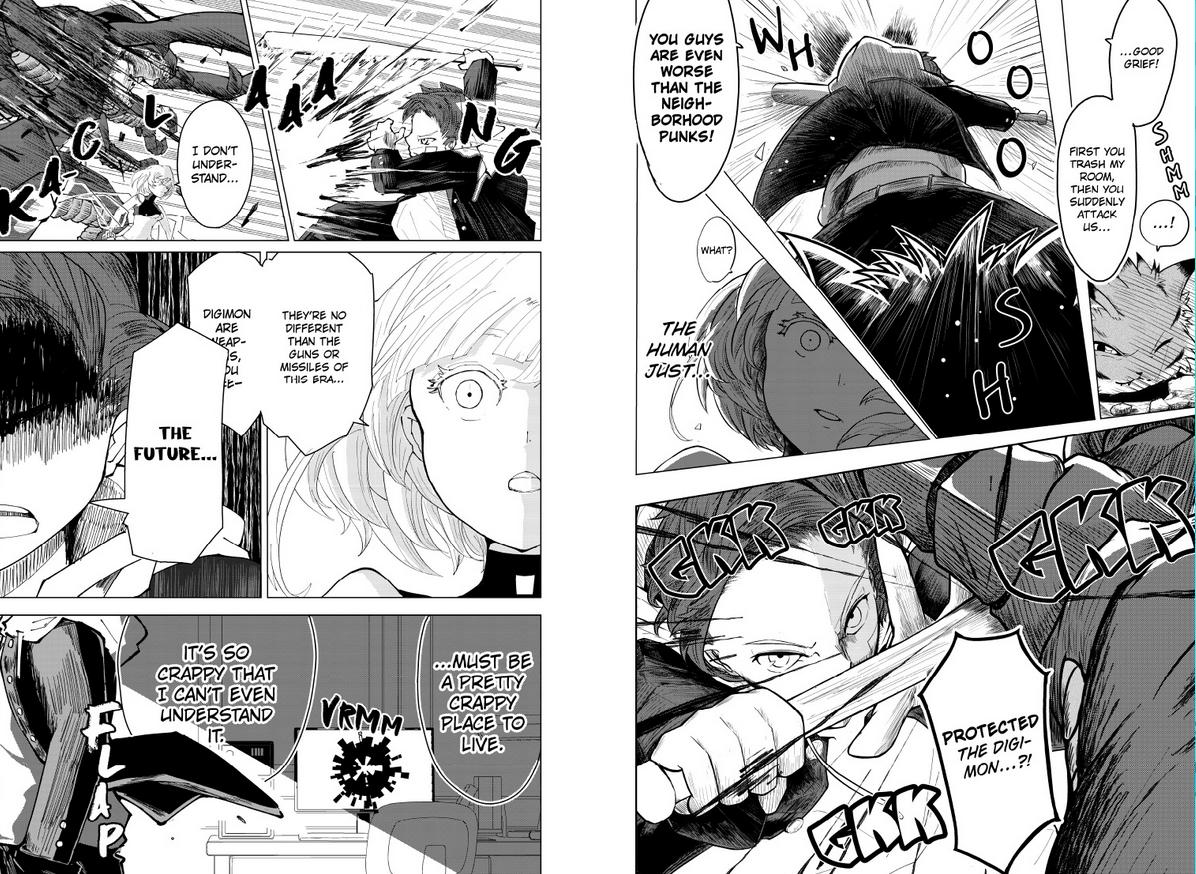
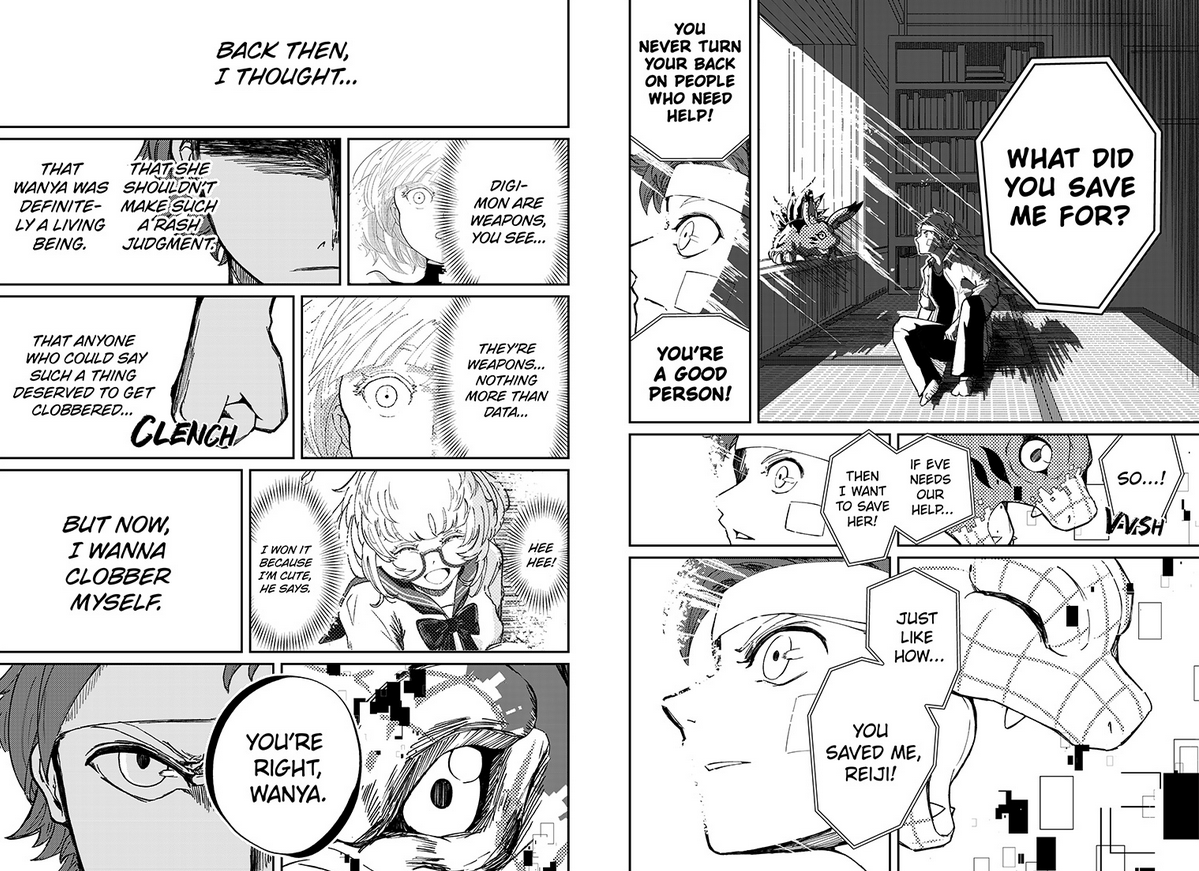 On the completely opposite end of the spectrum, Digimon Survive (which itself is inspired by a scene in Digimon Adventure 02) treats digimon as something akin to youkai or gods; even the term ‘digimon’ is only dropped towards the very end, with the monsters in question being called kemonogami (beast gods) for most of the story.
On the completely opposite end of the spectrum, Digimon Survive (which itself is inspired by a scene in Digimon Adventure 02) treats digimon as something akin to youkai or gods; even the term ‘digimon’ is only dropped towards the very end, with the monsters in question being called kemonogami (beast gods) for most of the story.
And a torii, of course, is a barrier between the spirit world and the normal one; using one as a weapon against a digimon is symbolically very fitting.
 Eve’s timeline is a bleak one, the kind where one can not help but be reminded of Dragon Ball Z’s Mirai Trunks – it’s very much a case of ‘go back to change the past’. She’s an AI because humanity all but destroyed itself with pollution and nuclear war, and ceded their power to machines in the hope they’d do a better job, she doesn’t know what clear skies look like. She’s not the only AI made – there were seven – and the conflict between two of them drives Wanyamon’s origins and much of the story, while presenting a unique take on the origins of digimon...
Eve’s timeline is a bleak one, the kind where one can not help but be reminded of Dragon Ball Z’s Mirai Trunks – it’s very much a case of ‘go back to change the past’. She’s an AI because humanity all but destroyed itself with pollution and nuclear war, and ceded their power to machines in the hope they’d do a better job, she doesn’t know what clear skies look like. She’s not the only AI made – there were seven – and the conflict between two of them drives Wanyamon’s origins and much of the story, while presenting a unique take on the origins of digimon...
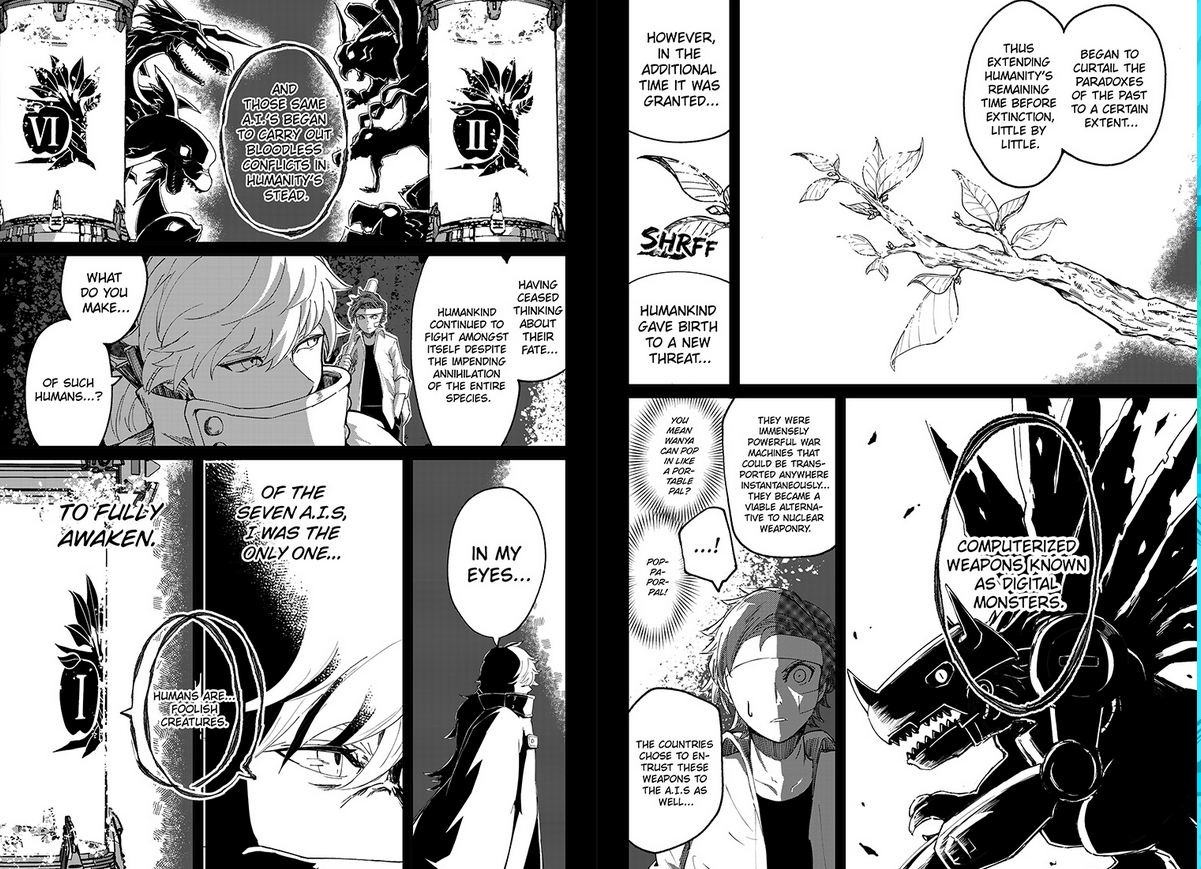
I’m impressed with the conclusion, although it’s hard to talk about without giving too much away… the short story format does Paradox a real favor, I think, I’ve seen more than one time paradox story write itself into a corner. But this one has a really satisfying resolution, much more than a big dramatic fight would have been. Plus we get a cool timeline of the future at the very end.
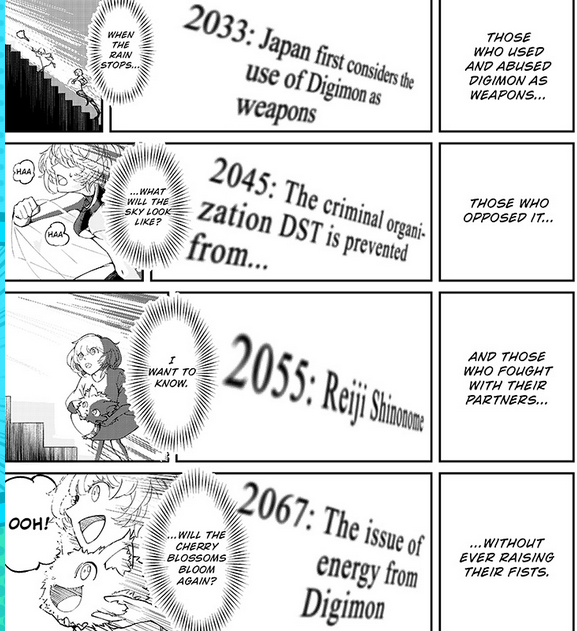
From its August 1st date to its accurately reproduced digimon merchandise to its copious amounts of butterflies, Digimon Rikollection is a reference-laden, nostalgic tour de force.
Yet there’s more to this story than just fanservice; a beloved digimon game ends its service (in a non-so-subtle criticism of how Bandai’s treated its real equivalents), digimon toys are brought to life, and a traumatized older brother for whom digimon were just a dream.
Digimon have a way of going beyond the boundaries of reality, of blurring the lines between fact and fiction, of feeling like a dream, and the series is thick with this theme… and also we get a proper Digimon Savers Masaru Punch. (The manga uses card slashes ala Digimon Tamers as well.) Toys coming to life, digimon having their own existence beyond the game’s servers, it’s an old idea in the franchise but treating it so directly leads to a neat type of story.
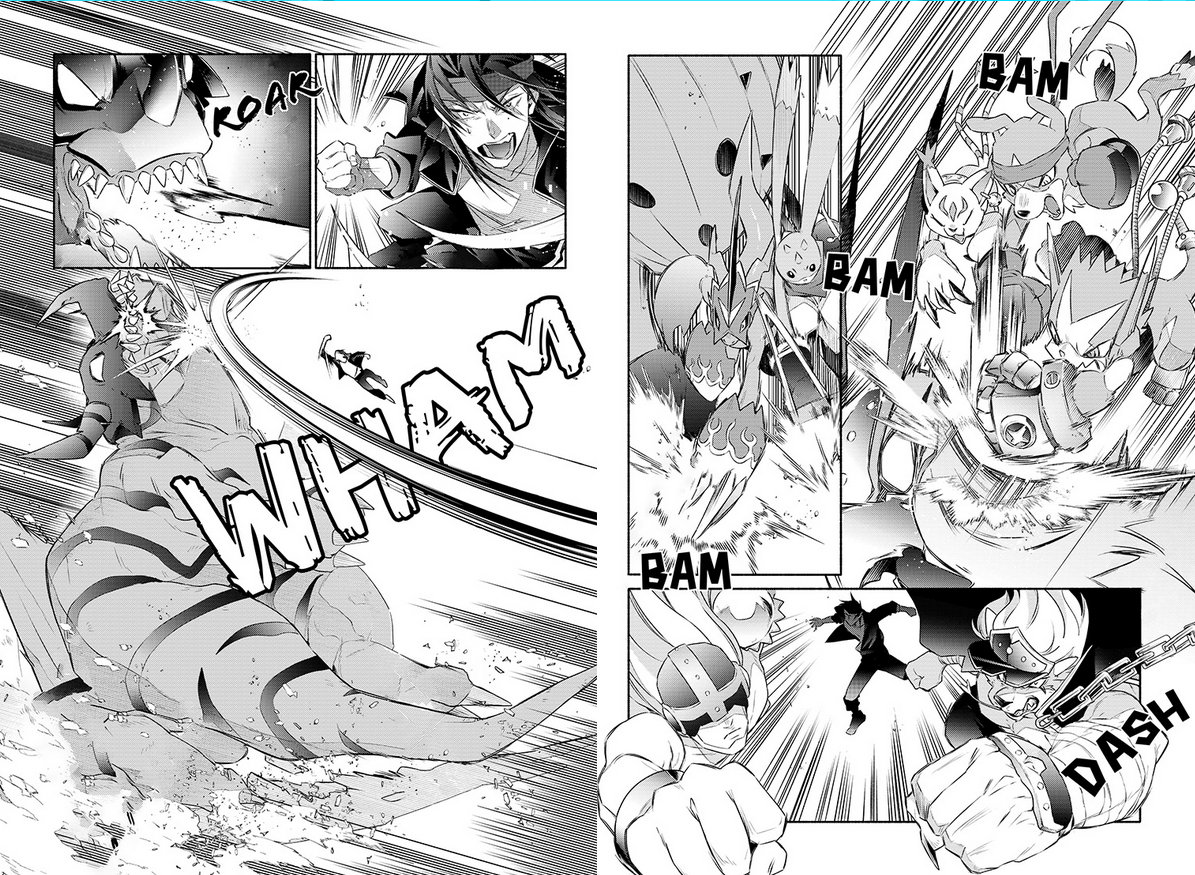 Every digimon and piece of scenery to appear is clearly thought through, and although it takes a broad outline from Bokura no War Game there are just endless bonuses where one can tell specifically what a Geogreymon or a Terriermon or whatnot is doing there.
Every digimon and piece of scenery to appear is clearly thought through, and although it takes a broad outline from Bokura no War Game there are just endless bonuses where one can tell specifically what a Geogreymon or a Terriermon or whatnot is doing there.
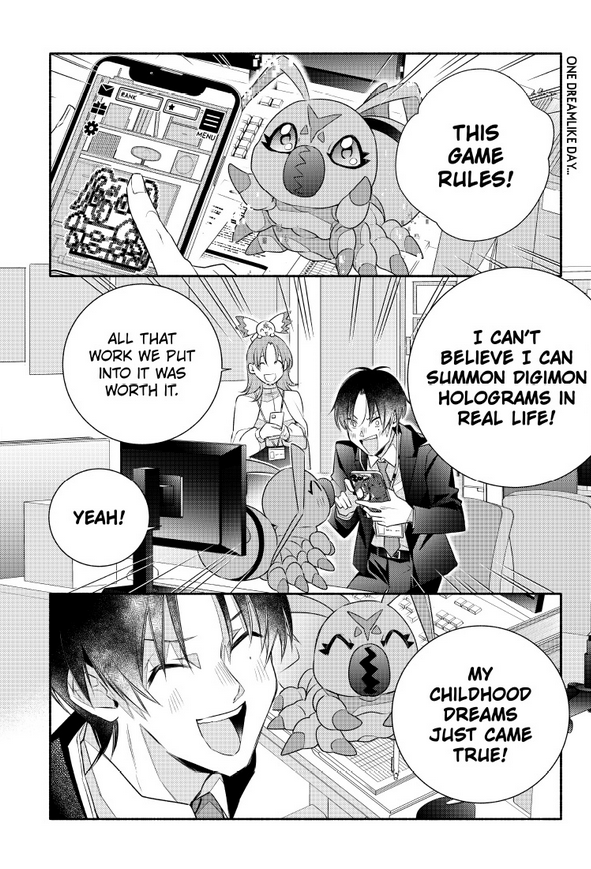 In the end, it doesn’t matter what human society or even the law wants, or even what makes TOEI and Bandai the most money. Digimon are an existence beyond that. I think that’s kind of the essence of being a true fan, of anything, and Rikollection speaks to it so perfectly.
In the end, it doesn’t matter what human society or even the law wants, or even what makes TOEI and Bandai the most money. Digimon are an existence beyond that. I think that’s kind of the essence of being a true fan, of anything, and Rikollection speaks to it so perfectly.

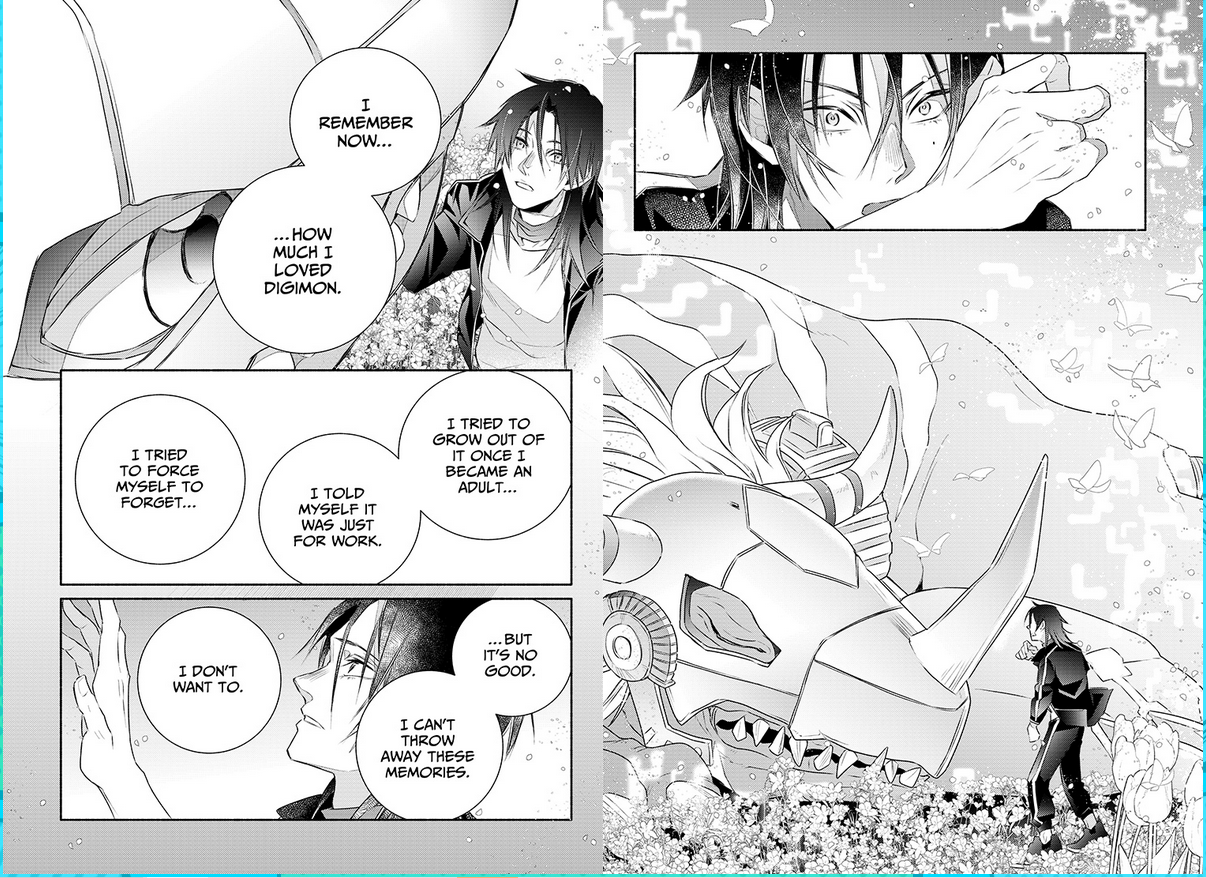
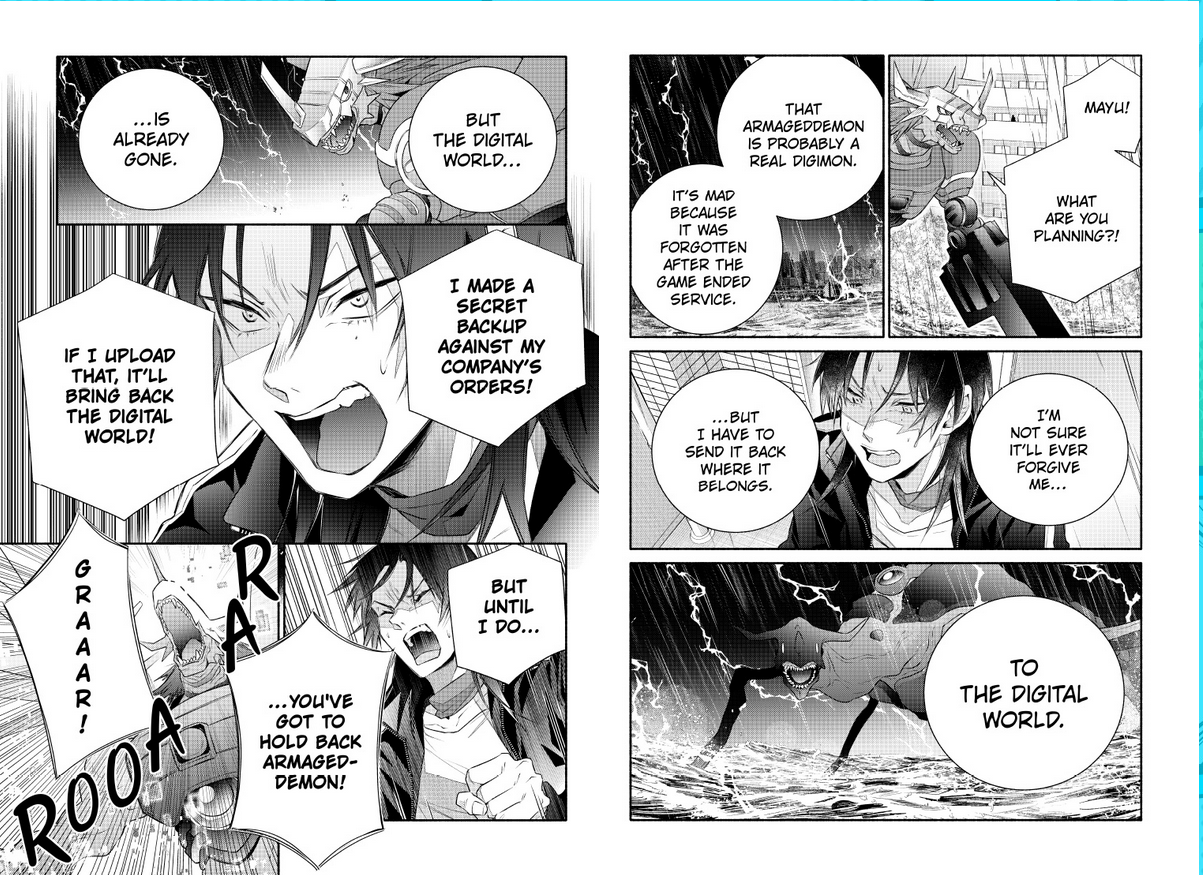
I like to think that I was there, on the protagonist’s side… just like when Omegamon fought Diablomon.
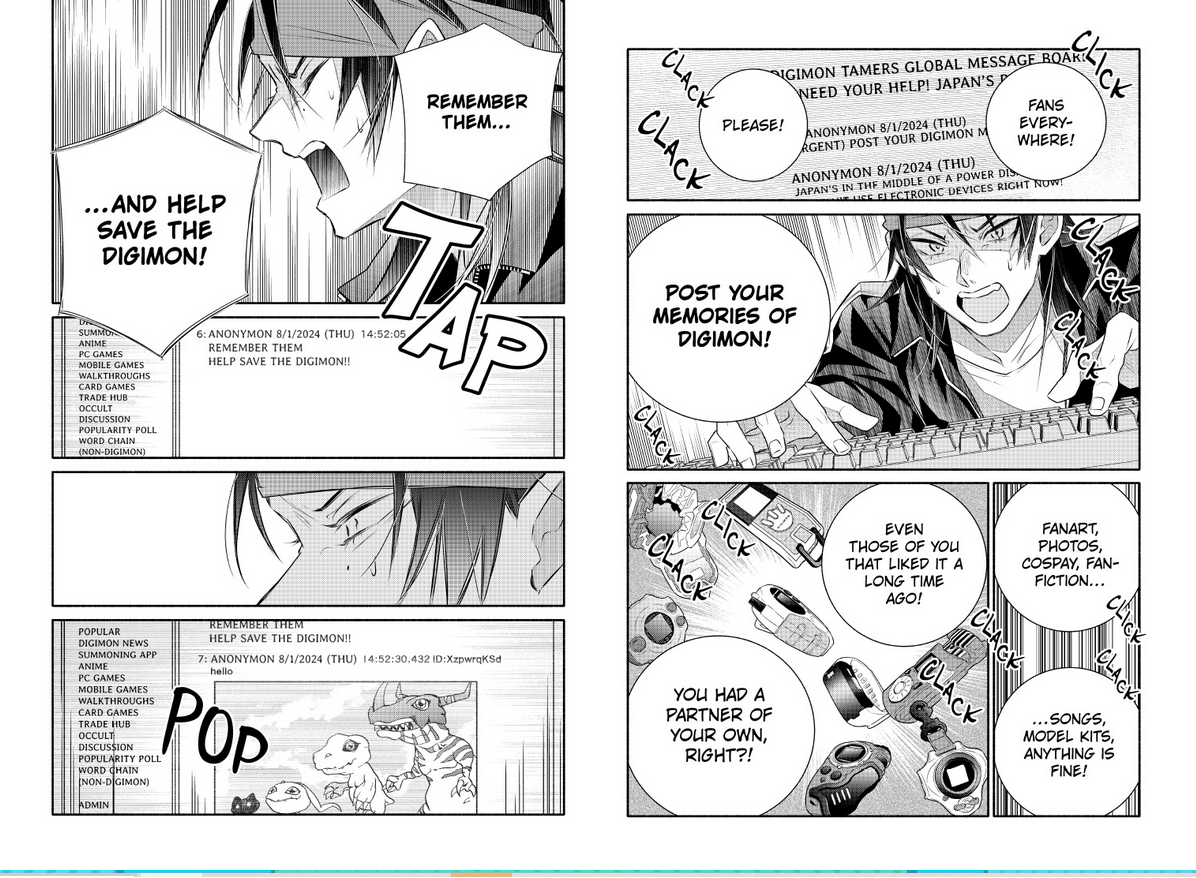
Daimon Suguru and Masaru, Amanokawa Hokuto and Hiro, one could even rope in Hida Hiroki and Iori, although the former’s death was unrelated… there’s a long digimon tradition of fathers getting involved with digimon and causing problems in the process. Digimon Knuckles’ Haruka has a similar issue with his dad Hajime, leaving Gankoomon to stand in for him.
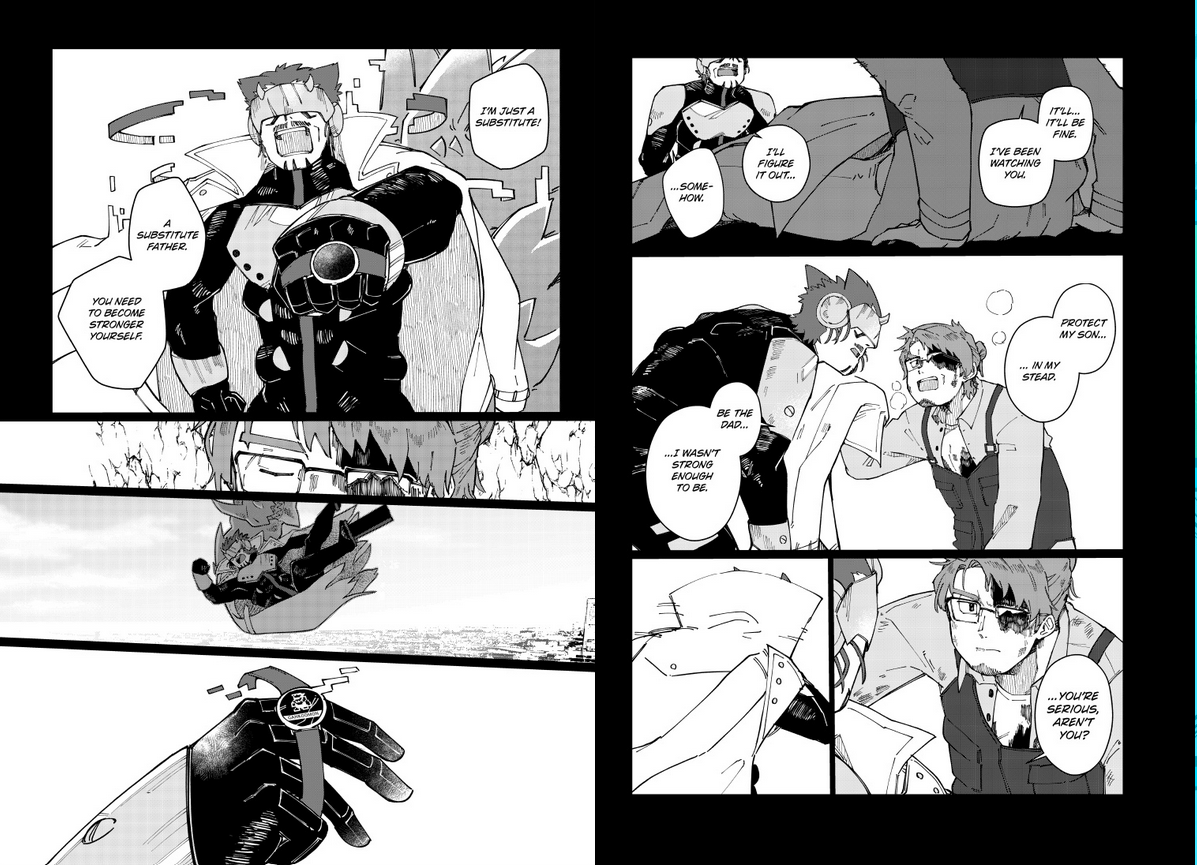 Knuckles isn’t just a father and son tale, although that’s the part which sticks out most. It’s also about the interaction between two very different societies and worlds. If this sounds a lot like Savers so far… it does have a similar feel, but the digital world of Knuckles is a lot more like that portrayed in some of the earlier virtual pets, and Digital Monster X:Evolution is its only real counterpart in digimon animation.
Knuckles isn’t just a father and son tale, although that’s the part which sticks out most. It’s also about the interaction between two very different societies and worlds. If this sounds a lot like Savers so far… it does have a similar feel, but the digital world of Knuckles is a lot more like that portrayed in some of the earlier virtual pets, and Digital Monster X:Evolution is its only real counterpart in digimon animation.
Yet while many digimon are interested in invading the human world, Gankoomon wants to create a digimon school so weaker digimon could develop… and Hajime saw the potential of the digital world as a place to evacuate from natural disasters. I think there’s a really neat story that one could base around that idea, a human community stranded in the digital world after a nasty earthquake or volcanic eruption, but I digress. We also have Pajiramon’s arrows causing nightmares, a concept which only shows up for one battle, but could make for some very interesting interactions in its own right with a mysterious other world.
 Gankoomon seems like just a dad at first, but he has his own problems and doubts, and is a surprisingly compelling character for such a short manga, almost stealing the show from Haruka. Then again, we get to see their teamwork as well, with Haruka even helping win a battle.
Gankoomon seems like just a dad at first, but he has his own problems and doubts, and is a surprisingly compelling character for such a short manga, almost stealing the show from Haruka. Then again, we get to see their teamwork as well, with Haruka even helping win a battle.
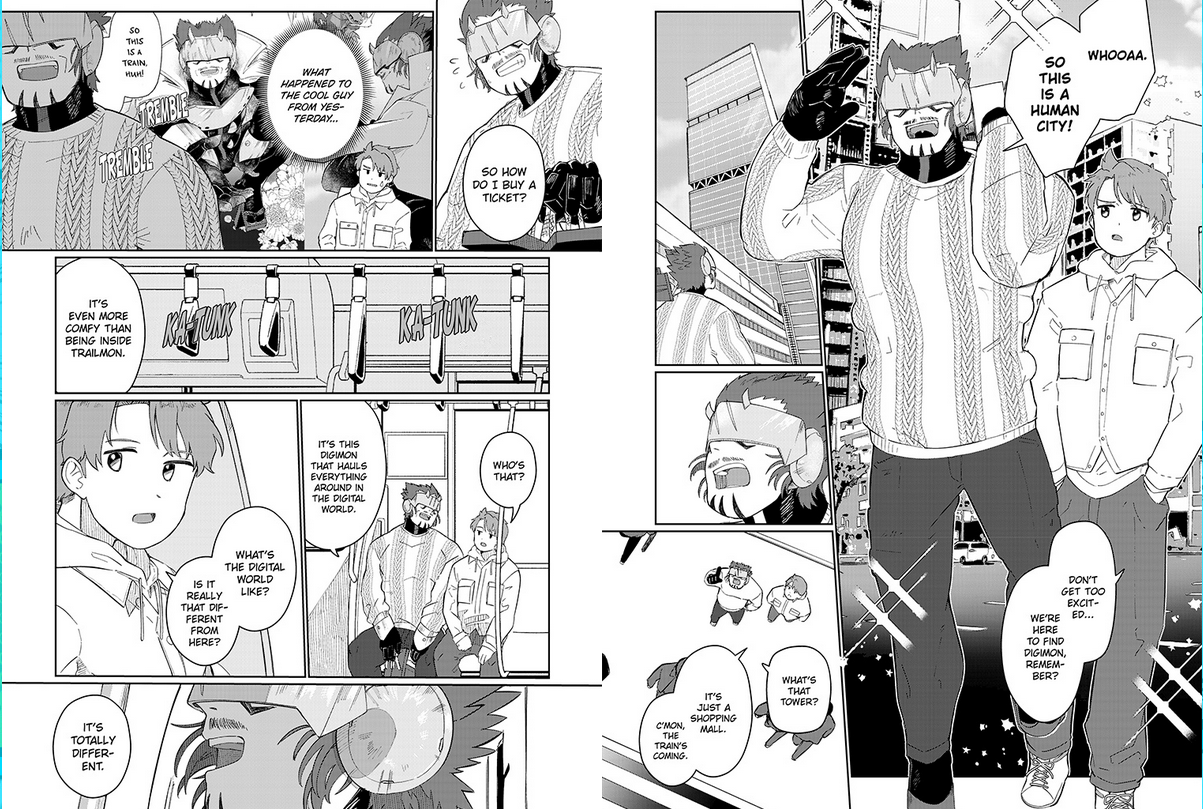
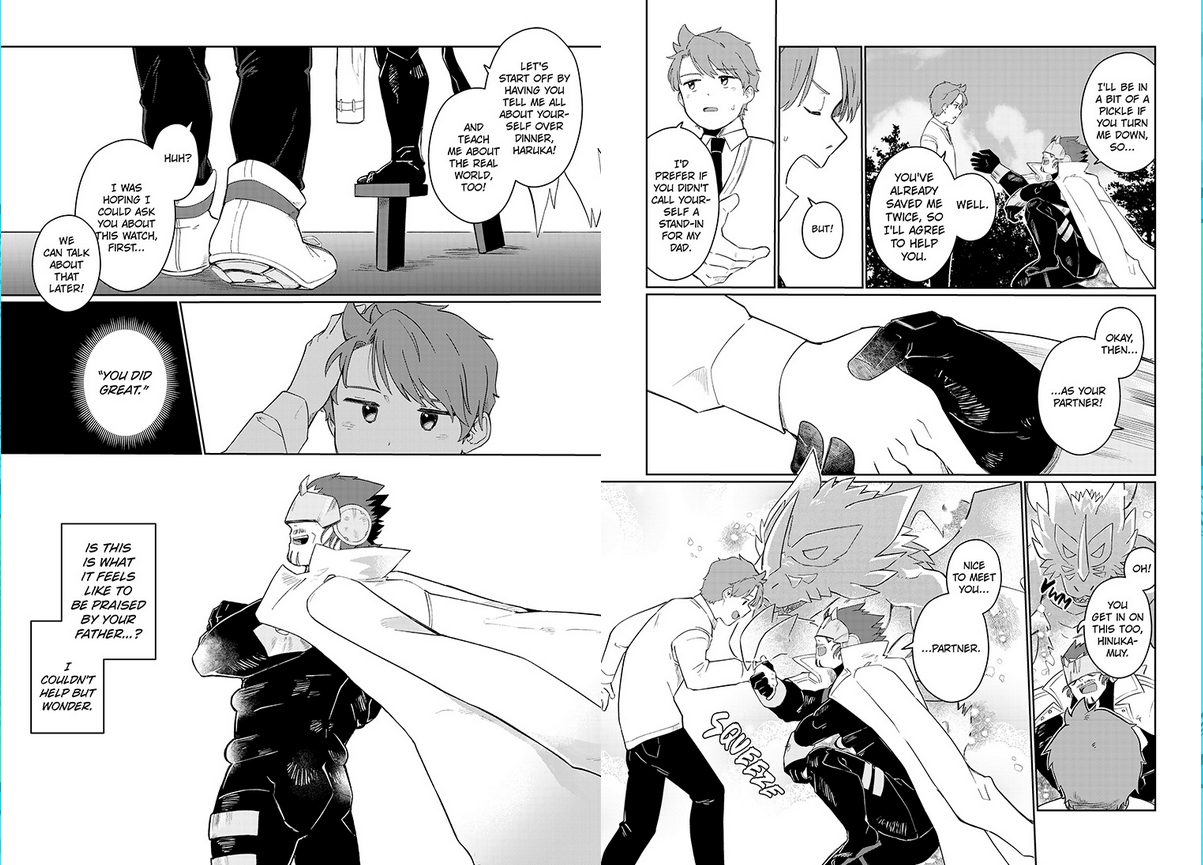 And, just like Hajime to Haruka, a parent who did everything for his son but didn’t tell him anything, Gankoomon hasn’t been perfect as a mentor… Gankoomon’s master-apprentice relationship with Hackmon has showed up in a lot of digimon media, most memorably (until now) the Digimon Adventure PSP postgame, and here things go very sideways.
And, just like Hajime to Haruka, a parent who did everything for his son but didn’t tell him anything, Gankoomon hasn’t been perfect as a mentor… Gankoomon’s master-apprentice relationship with Hackmon has showed up in a lot of digimon media, most memorably (until now) the Digimon Adventure PSP postgame, and here things go very sideways.
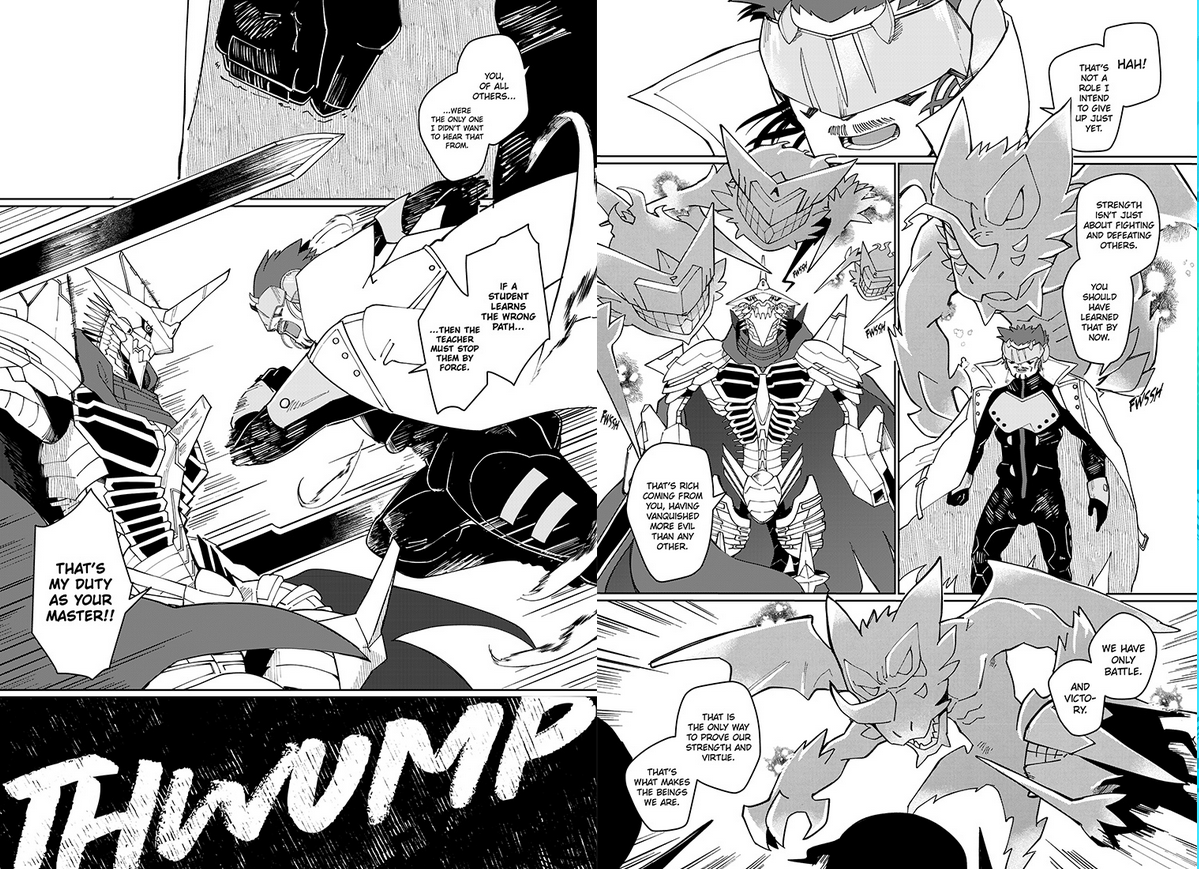 And of course, when the digimon invade, when all is said and done… I can’t think of anyone you’d rather have deliver a punch! There’s some cool stuff in the background, there are touching family moments… and there are also some really fun action scenes.
And of course, when the digimon invade, when all is said and done… I can’t think of anyone you’d rather have deliver a punch! There’s some cool stuff in the background, there are touching family moments… and there are also some really fun action scenes.
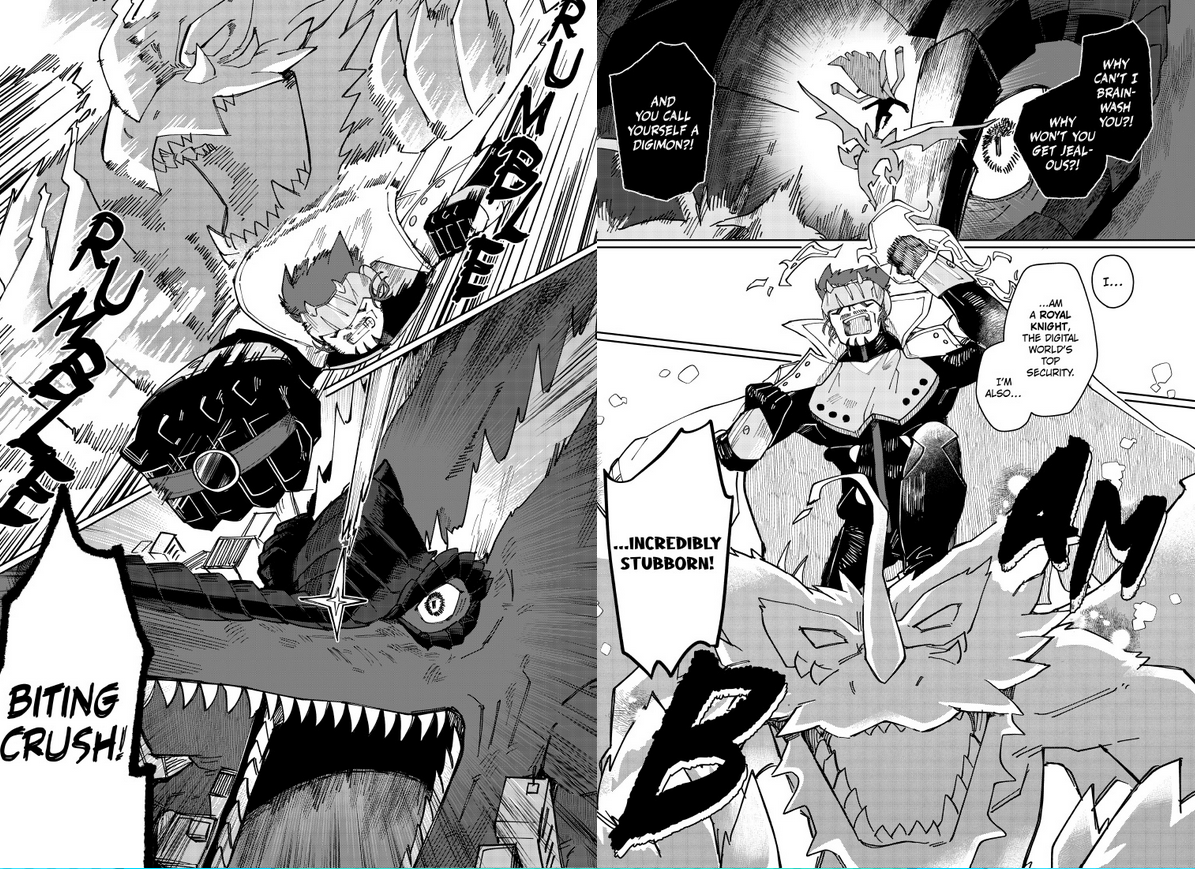
Mini Digimon: The Story of the Royal Knights is something of an odd fit within the Digimon Comic collection, both as a gag manga and as the work of a franchise veteran; it shares a mangaka in Yabuno Tenya with the 25 chapter Digimon Dreamers, and, were it not for the focus on the Royal Knights instead of Pulsemon, it could almost have been mistaken for new chapters of that manga.
That said, this manga (unlike Dreamers) is not an isekai, as it takes place entirely within the digital world and features no human characters.
Still, it’s nice to have a franchise legend in with the newbies; Yabuno Tenya also, way back in 1998, drew Digimon Adventure: V-Tamer 01.
Anyway, it starts with a Wanyamon being used as a soccer ball by some shady digimon… before being rescued by Dynasmon.
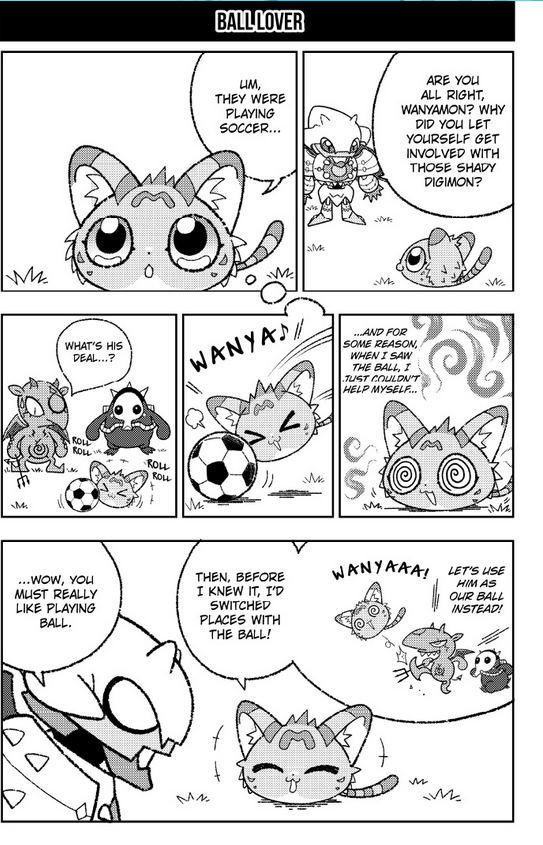
Wanyamon becomes a huge fan, much to its savior’s annoyance, and (this being a gag manga) eventually gets kicked by Dynasmon himself. Wanyamon goes one by one to collect the Royal Knights’ signatures… and, considering that this manga runs alongside Knuckles, I thought the Hackmon page was a good representative. Paradox features a Wanyamon too, for that matter…

And then we have Omegamon doing a “jogress” with his WarGreymon and MetalGarurumon hands, or bug catching a GranKuwagamon. I never know what to highlight with gag manga; it’s possible, depending on your sense of humor, that I picked the wrong pages to hook people. Still, I liked these ones in particular.
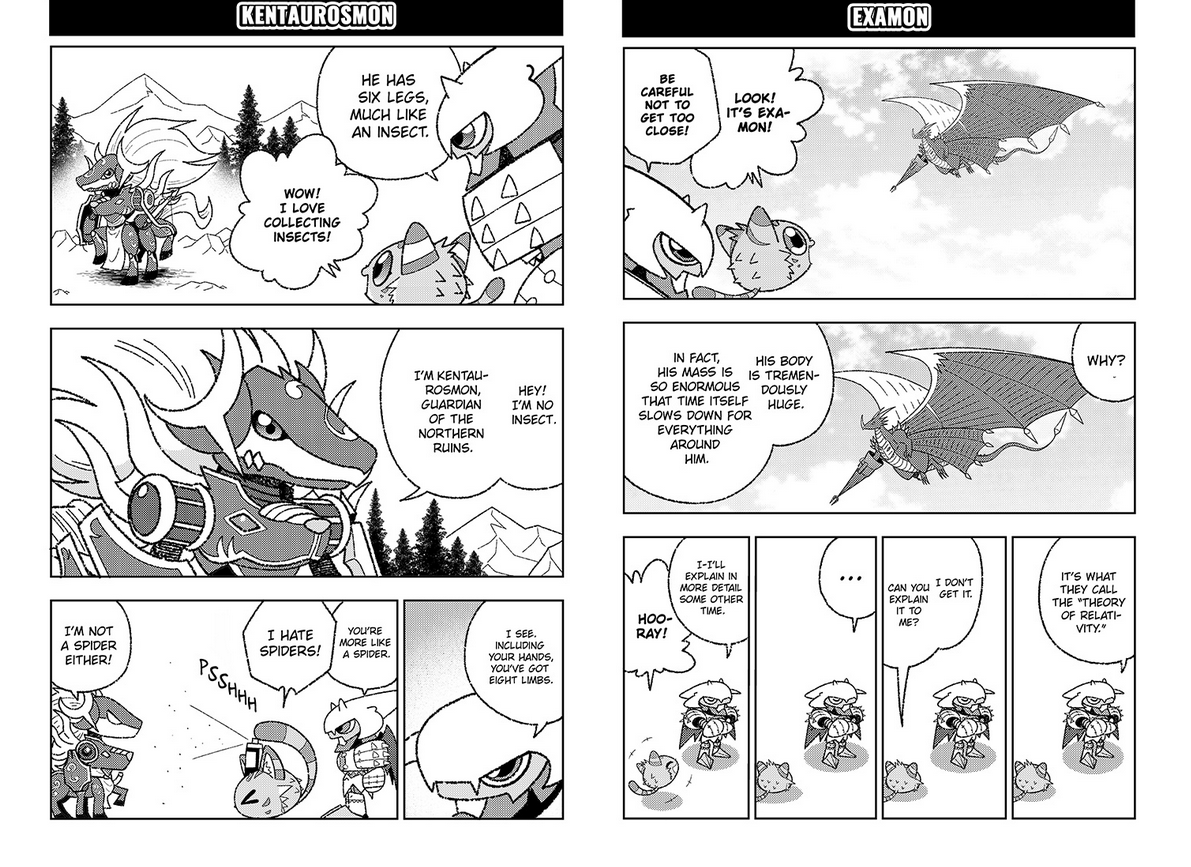
Wanyamon’s impressive in its own right, and there are hints that it’s a notable digimon in its own right, reincarnated into baby form. It kind of reminds me of the overleveled baby digimon in some of the Digimon Story games. It’s not every baby digimon who poops on the heads of multiple royal knights and lives to tell the tale...
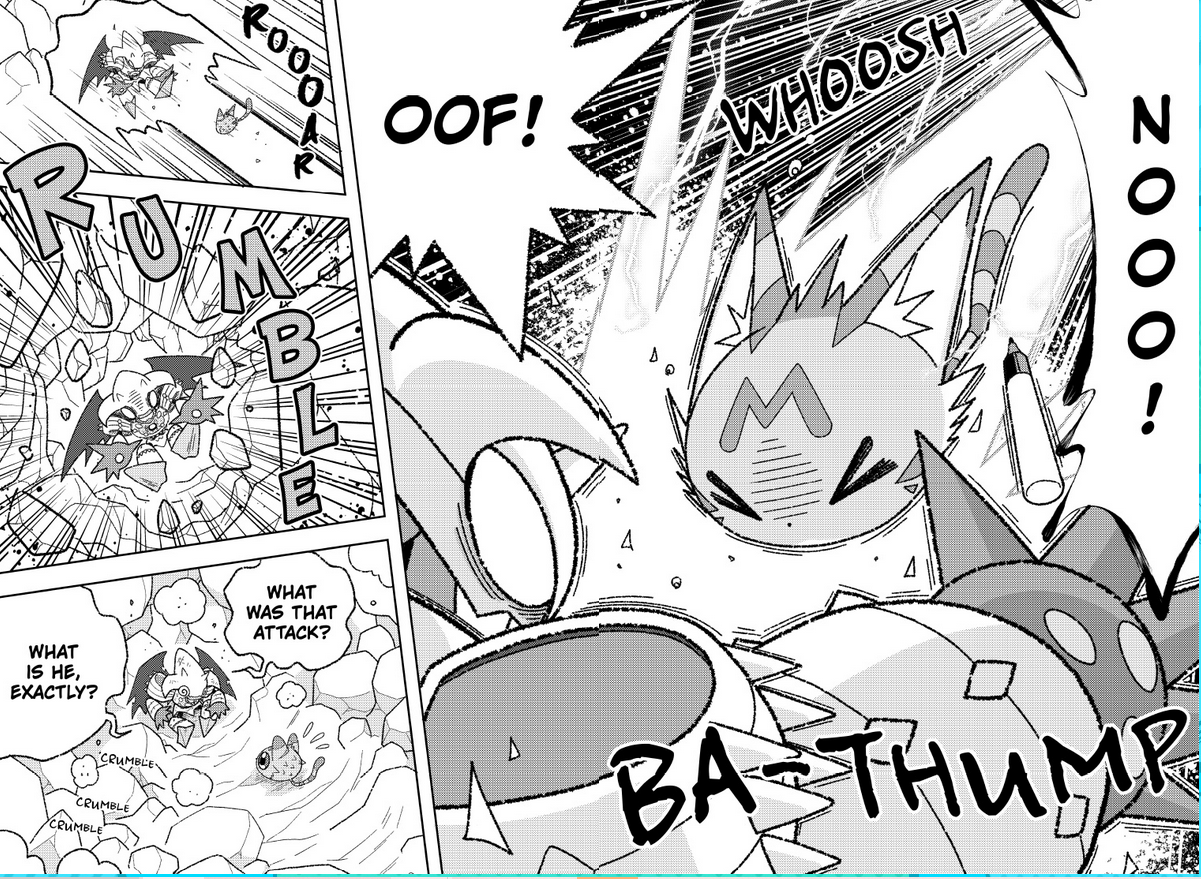
Or knocks back Dynasmon, for that matter. Mini Story is very much a change of pace, and not personally my favorite… but it’s definitely good for a laugh.
Digimon Seekers gets four chapters worth of spinoff manga by a single author, Hajime Kariki, but they’re divided into two distinct short stories, The Crossroad Witch and Wall Slum’s Nightmare. Seekers itself is a remarkable serialized web novel, unique within the digimon franchise, a story in a cyberpunk setting about researchers linking minds with digimon and mysteries around some of them going comatose in the process of digital world exploration; it’s attracted a decent following in Japan, but its popularity in the English-speaking world was unfortunately undercut by a poor translation of the first chapter. A fan translation exists of the first chapter and much of the second, and the official translations of chapters two through four are significantly better.
The Crossroad Witch is a story about Shuu Yulin, DigiPolice official and old friend Saya Ryusenji; Seekers itself revolves around Saya going Digital Missing In Action. But first, this manga gives us some disturbing foreshadowing, before showing her fate in the very next page…
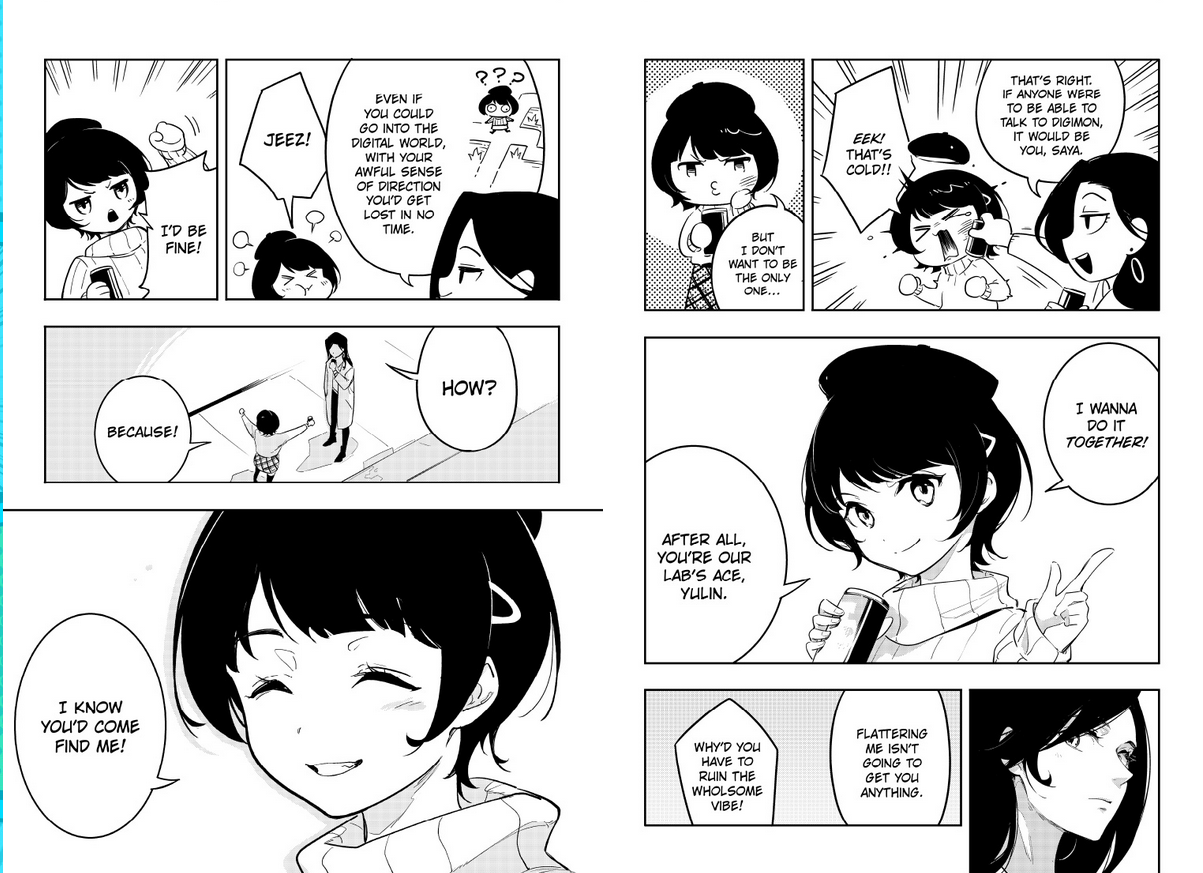
We unfortunately do not learn the origin of Yulin’s nickname in this work, despite it providing the story’s title; she is already called a witch by her digimon partner at the time of her first meeting. We do get a cool, multiple page scene of her entry into the digital world, however, including floating through a layer of stray data before showing the classic isekai falling scene. And we get to see a younger, pre-Digipolice character design of our protagonist.
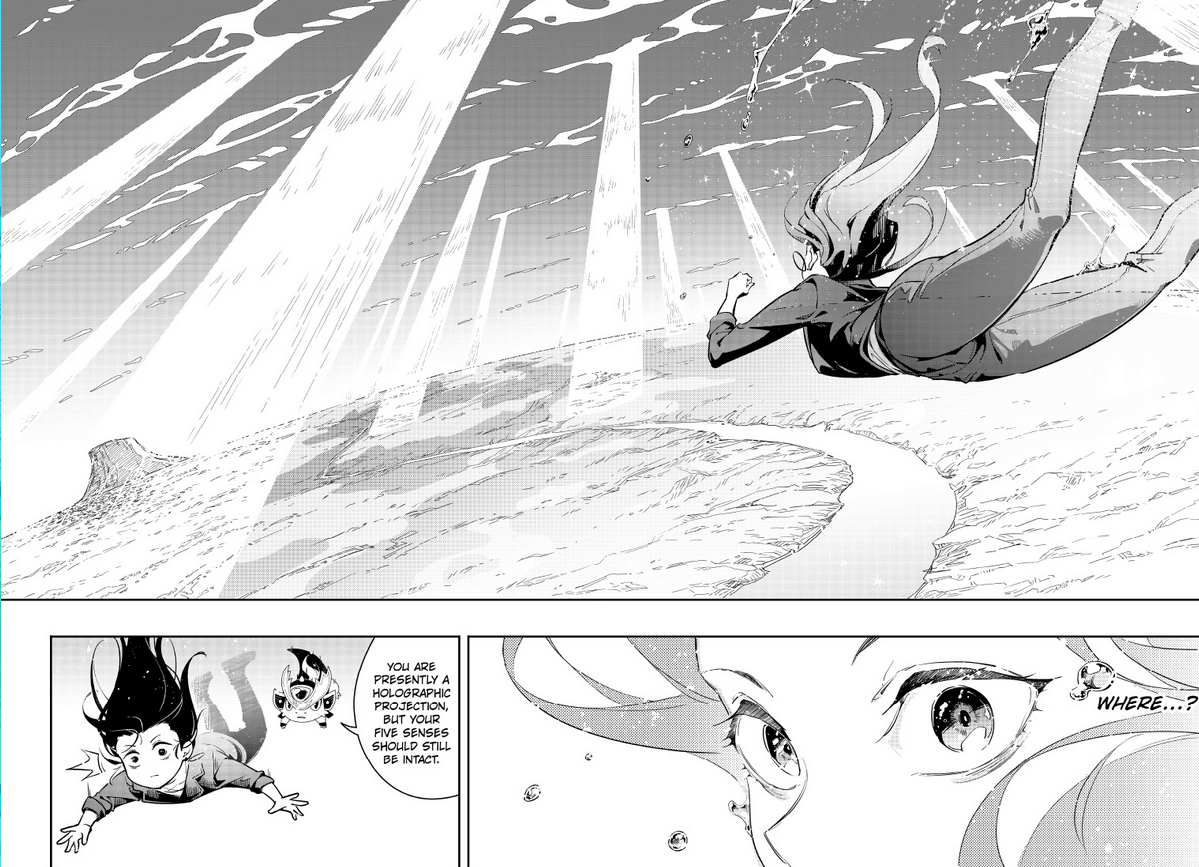 She’s there to look for Saya’s digimon partner, a BlackAgumon, and finds a lead in a crime lord WaruMonzaemon’s fortress.
She’s there to look for Saya’s digimon partner, a BlackAgumon, and finds a lead in a crime lord WaruMonzaemon’s fortress.
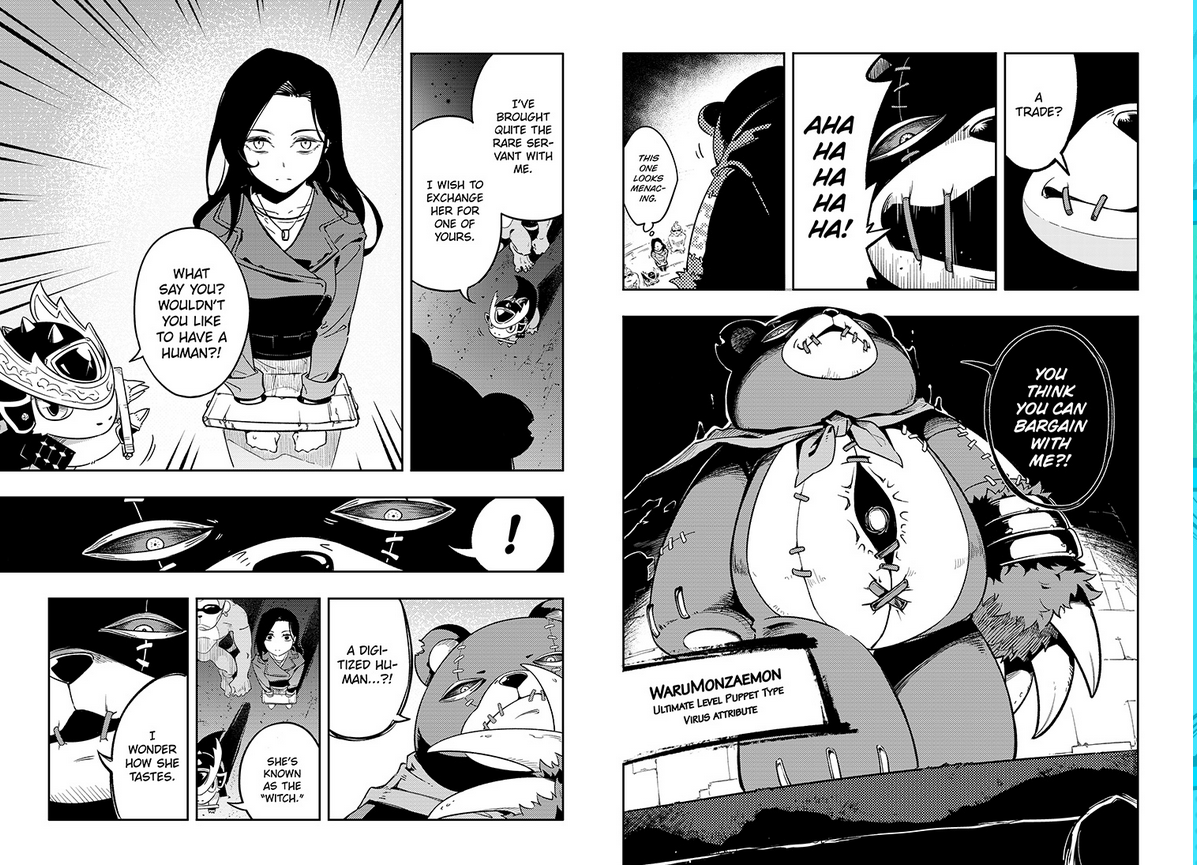 Yulin offers to cut a deal, exchanging herself for the BlackAgumon, but she has no intention of upholding the deal’s spirit and intends to delink after the fact. WaruMonzaemon sees no reason to make a trade when he could just eat her, and has already captured many of the digimon she sent into the digital world to search for Saya’s partner. And then there’s a neat battle with Ryudamon showing off his samurai spirit.
Yulin offers to cut a deal, exchanging herself for the BlackAgumon, but she has no intention of upholding the deal’s spirit and intends to delink after the fact. WaruMonzaemon sees no reason to make a trade when he could just eat her, and has already captured many of the digimon she sent into the digital world to search for Saya’s partner. And then there’s a neat battle with Ryudamon showing off his samurai spirit.
Things can’t be resolved for good, this being a prequel, and it should be no spoiler that the lead doesn’t pan out. But it’s an impressive look into the world of Seekers before Eiji got involved and before Yulin became the DigiPolice chief, and things are really rough for ordinary digimon in WaruMonzaemon’s domain…
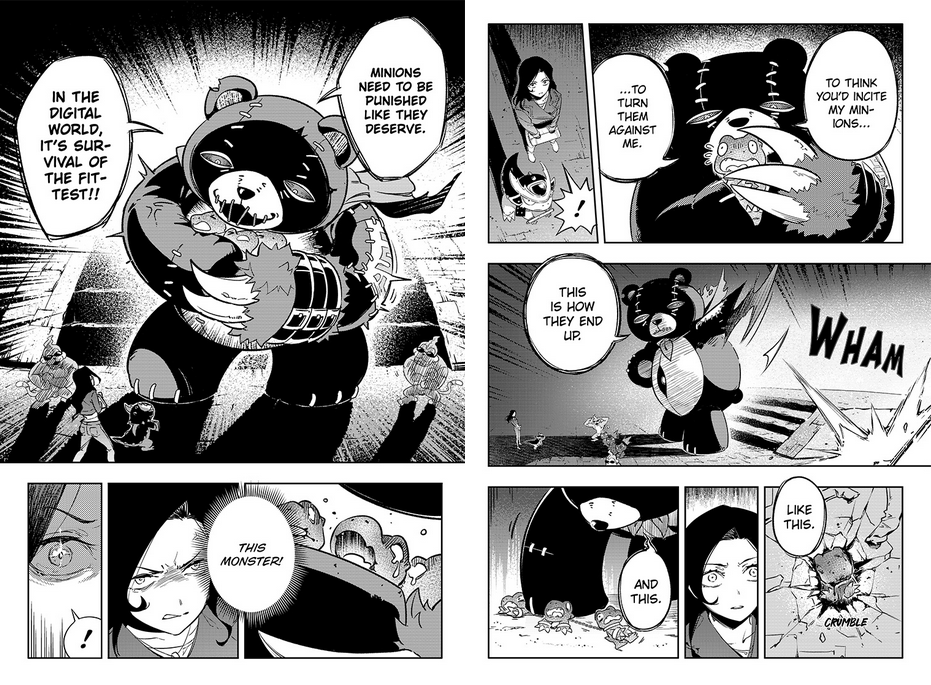
then again, that kind of thing is how we got Wall Slum to begin with.
Wall Slum’s Nightmare is set after the events of Seekers, so we have both a prequel and a sequel manga. Although Eiji and Loogamon, just as in Seekers are the main characters, Shuu Yulin, Satsuki Tamahime, and Leon Alexander all make appearances. The story begins with Eiji and Loogamon receiving news of a conflict in another of Wall Slum’s avenues, and, as an area boss, Loogamon needs to investigate.
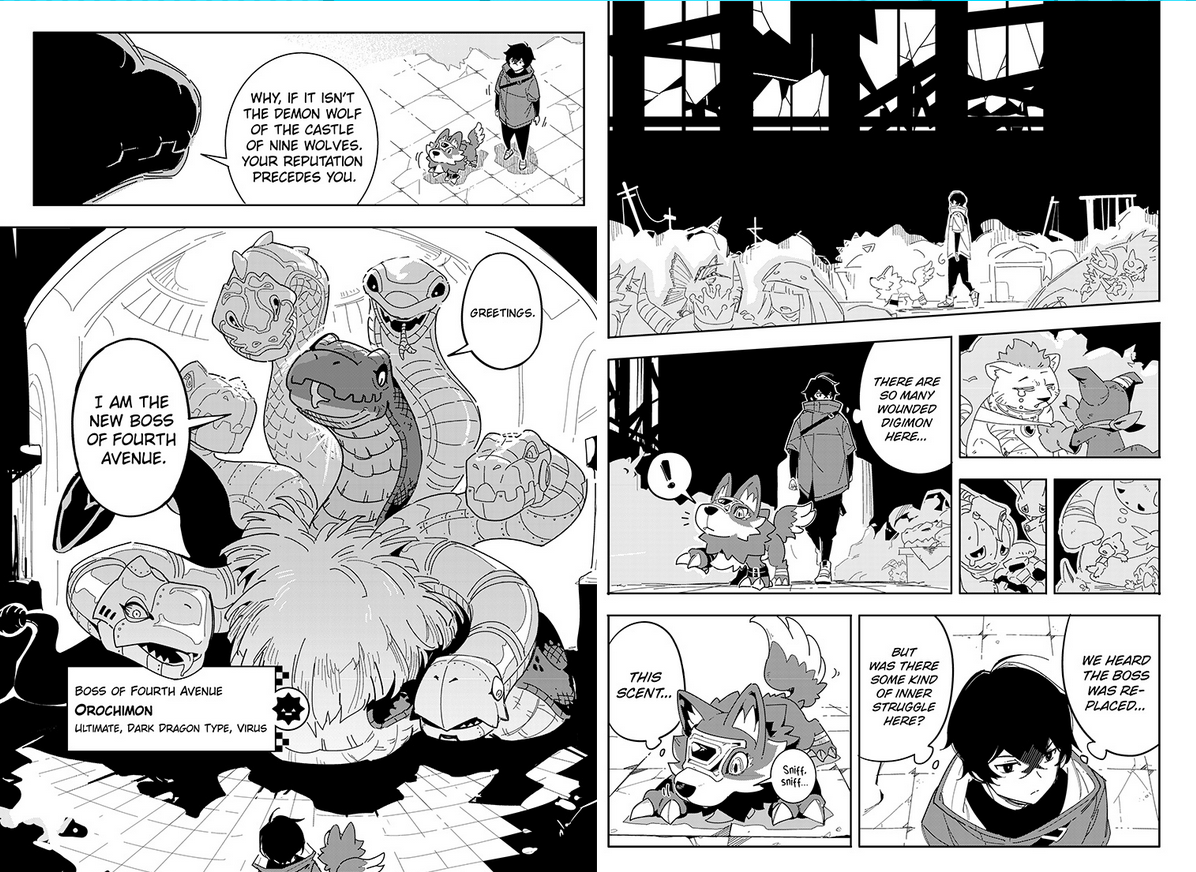
As they investigate further, things center around a digimon loving researcher who went DMIA, and her Orochimon → Nidhoggmon partner, who makes a tragic attempt to destroy Wall Slum in order to spare the digimon tossed aside their suffering… or just a dark evolution gone berserk. In a different timeline, maybe I could’ve been in her position; this story hits hard.
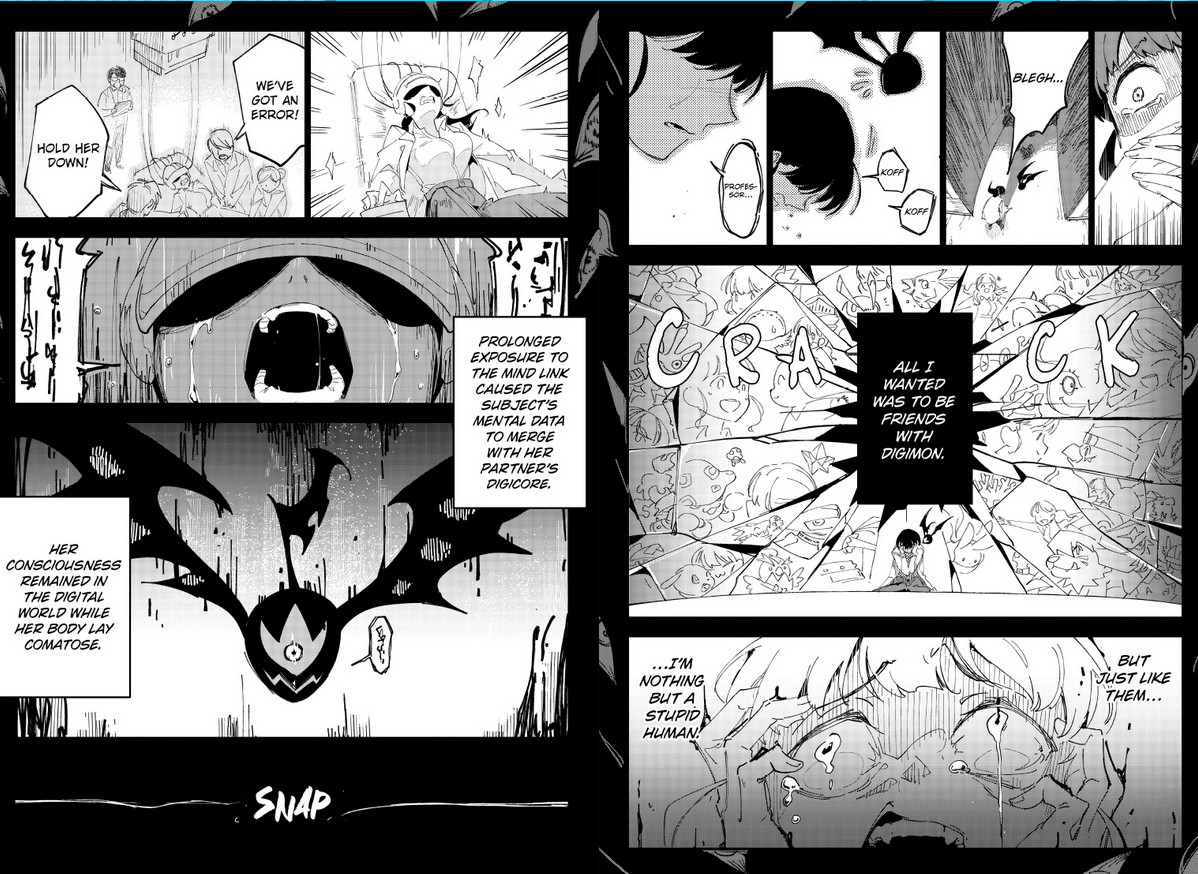
As I write this, promortalism has made global news, as the iddedology appears to have inspired the culprit behind the bombing of an IVF clinic in Los Angeles. It is not difficult to find advocates for negative utilitarianism on the internet – and the cast-off digimon of Wall Slum certainly have their share of unhappiness, probably greater reasons for complaint than the average human. On the other hand…

The final entry in Digimon Comic is Digimon Get Back, a one-shot released in the concluding volume, about a chosen child who ran away from the digital world and grew into a sad adult. Many a destined hero, both inside and outside of digimon, responds with initial doubts and fears; of the manga I’m currently reading, Classmate wa Isekai de Yuusha ni Natta kedo, Ore dake Gendai Nihon ni Okizari ni Narimashita has a similar premise of being left behind, although in that case it was a paperwork mix-up and not the protagonist’s fault.
The concept of losing because they were one short has precedent in digimon; it’s why the Adventure group needed to find the 8th child, after all, and Adventure has cast a very long shadow on other mid-season additions. (Besides, why find someone if you don’t need them?) It’s easy enough to imagine an older Hikari in the main character’s position, albeit because of illness and not cowardice.
If Get Back recalls any particular Digimon anime, however, down to the train tracks on the very first page, it’s Frontier - a group of five evolving into the ten legendary warriors, and Tomoki in particular was initially forced and gave serious thought to going home.
In any case, our protagonist, Osanai, ran away from the digital world, and the other four all disappeared; for all those long years, while outwardly a successful salaryman, he lived with deep regrets. He finds a wounded girl – a chosen child, Akira, still as young as the day she left. And without him, they lost.
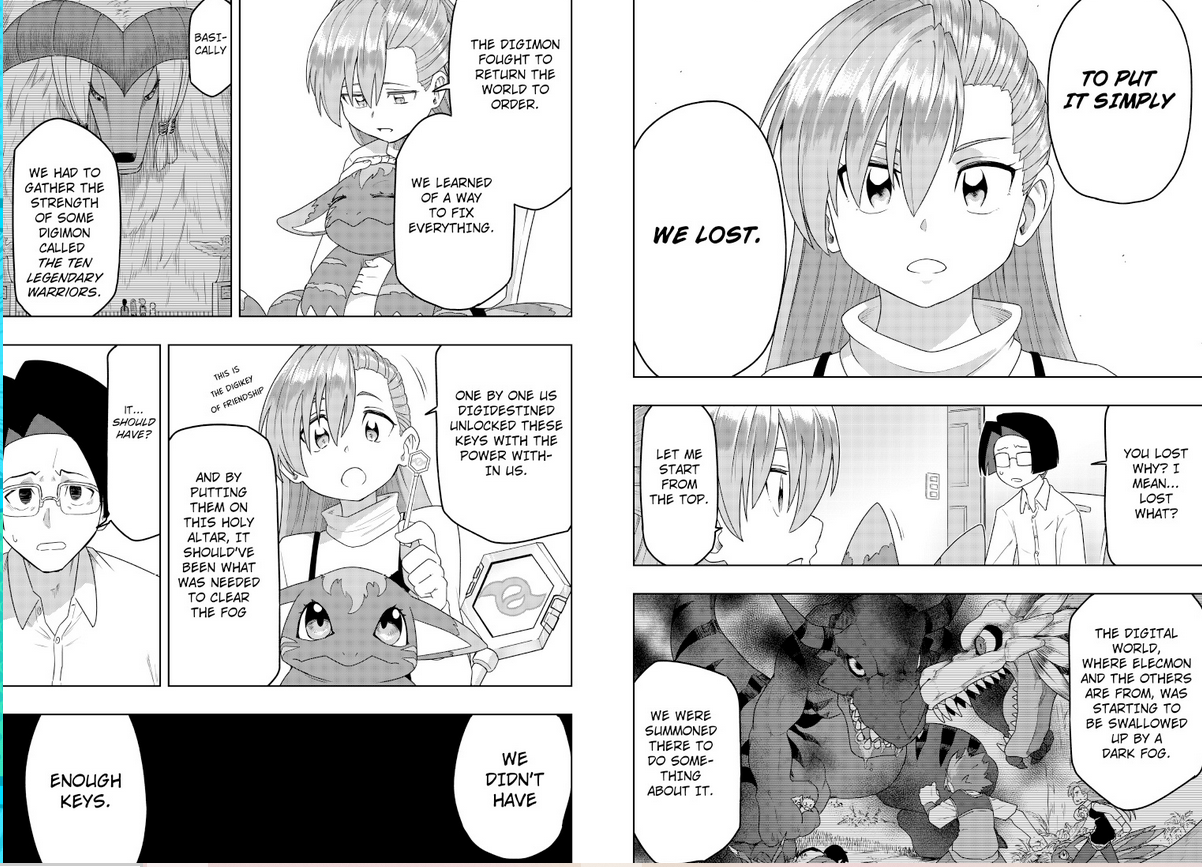
 Osanai is still afraid, and even flees, but he doesn’t squander his 2nd chance… and there’s something always inspiring about the moment a long-suffering adult befriends their digimon partner.
Osanai is still afraid, and even flees, but he doesn’t squander his 2nd chance… and there’s something always inspiring about the moment a long-suffering adult befriends their digimon partner.
 It’s not too late. For any of us.
It’s not too late. For any of us. Elecmon, I’m waiting…
Anyway, these comics are superb, and I can’t recommend them enough! If you haven’t yet, go read them, and I hope you enjoyed my thoughts.